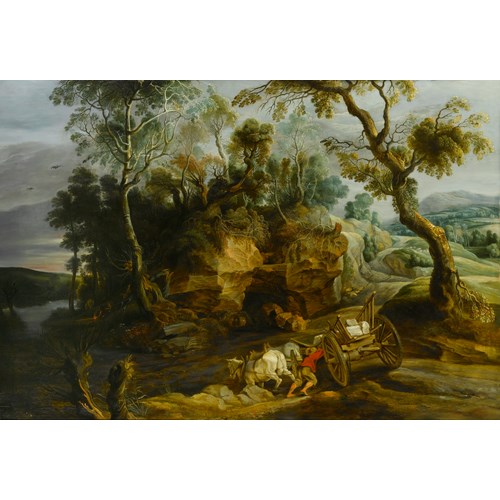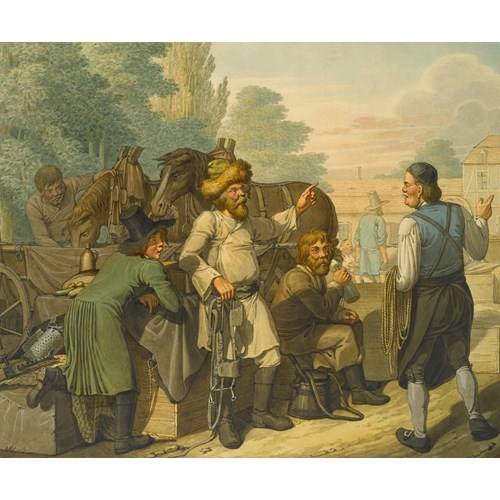Carle van Loo
Bacchus and Ariadne
Date 1732-1734
Period 1600-1750, 18th century
Origin France, Italy
Medium Oil on canvas laid on board
Dimension 110.5 x 142 cm (43¹/₂ x 55⁷/₈ inches)
Van Loo has depicted the moment Bacchus and Ariadne meet on the shore of Naxos. They look adoringly into each other’s eyes and the god gently takes the young princess by the hand. Above Ariadne’s head a putto has taken her crown, ready to be thrown to the heavens. Bacchus is dressed in his traditional leopard skin cloak, and the wreath of vines around his head reminds the viewer of his role as god of wine, as does the bunch of grapes in the lower left corner. Ariadne is dressed in beautiful silks and rests on a large luxurious pillow, reflecting her royal status. In her hand she suggestively holds Bacchus’ thyrsus, another of the god’s traditional attributes. A complex narrative has been condensed into an extremely concise and effective pictorial composition.
We know from an eighteenth-century auction catalogue that Bacchus and Ariadne originally formed part of a pair of paintings, the other being a depiction of Clytie and Apollo.¹ Unfortunately, Clytie and Apollo is currently lost, but we have a good idea of the composition Euterpe. Building upon the research of Marie-Catherine Sahut and Pierre Rosenberg,³ Ost explores the likely circumstances of the painting’s creation, c. 1732-1734. This was during van Loo’s Turin period, when his paintings are notable for their cool colours, precision of execution, and grace of draughtsmanship, particularly in his depiction of female heads. These are all qualities evident in Bacchus and Ariadne, and the treatment of faces and drapery are consistent with other paintings by van Loo from the 1730s, such as Castor and Pollox⁴, Mars and Venus,⁵ or the Rouen Madonna and Child. Similarly the depiction of the tree in Bacchus and Ariadne, is almost identical to that in another of van Loo’s Turin pictures, Armida Chaining Rinaldo.⁶
Although van Loo painted Bacchus and Ariadne in Turin, it seems it was almost immediately sent to Paris, to enter the collection of Victor Amadeus I, Prince of Carignano (1690-1741).⁷ Victor Amadeus was an Italian nobleman who had once been a great favourite of his father-in-law, Victor Amadeus II, King of Sicily and Sardinia (1666-1732). However, his profligate lifestyle meant that the young prince eventually quarrelled with the King, and left Italy to settle instead in Paris, where he owned extensive property. Over the years, Victor Amadeus filled the Hôtel de Soissons with an extensive art collection, and became a major figure in Parisian cultural life. He was a great patron of the van Loo family, in particular Carle’s elder brother Jean-Baptiste (1684-1745), who also served as his artistic advisor. He initially focused on collecting perennially sought-after sixteenth-century Italian paintings, but his tastes soon developed to encompass Dutch and Flemish work as well. Alongside this, Victor Amadeus was one of the leading patrons of contemporary French artists, including the van Loo family, Jean-Baptiste Pater (1695-1736) and Nicolas Lancret (1690-1743).
Although our painting is the primary version, it seems that van Loo may have painted a number of other variations of Bacchus and Ariadne. A 1766 Parisian auction sold a larger depiction of Bacchus and Ariadne, which, like our work, was also paired with a version of Clytie and Apollo.⁸ There is also a version recorded in the collection of van Loo’s brother-in-law, Lorenzo Somis, a resident of Turin.⁹ More recently an inferior variation appeared on the art market, which given slight compositional differences, and the much quicker and looser manner of execution, was perhaps a modello for our painting.¹⁰ Also worth noting is an engraving of Bacchus’ head by Louis-Marin Bonnet, which appears to derive from our painting.¹¹ Finally, there is a drawing in the Louvre, which also appears to depict Bacchus and Ariadne, along with two putti holding the crown. It has many significant differences from our work, most notably of course the vertical format. However, given that it does not relate to any other known painting, there is a possibility that it represents van Loo’s early thoughts for the composition of our work, before opting for a horizontal format.
In his article on our picture, Ost discusses several artistic sources that van Loo may have turned to in his planning of Bacchus and Ariadne, some contemporary and some ancient.¹² Sebastiano Ricci (1658-1734) had set a template for the depiction of this narrative, in a picture which sets the protagonists in a frieze-like composition focused, in a similar manner to van Loo, on the moment Bacchus tenderly takes Ariadne’s hand.¹³ Van Loo would also have known the treatment of the subject by one of his former teachers, Nicolas Vleughels (1668-1737), in which the figure of Bacchus is used to inject energy into the composition. Van Loo has taken elements from both this artists, so that the central tender moment, where the lovers are entranced by each other, is enhanced by the dynamism of Bacchus. However, for the figure of the god, rather than look to contemporary examples, van Loo seemed to have looked to the antique for inspiration, specifically the famous Discobolus, an ancient Greek sculpture known through later Roman copies. This image of coiled energy, centred around a twisted torso, clearly influenced the present work.
Carle van Loo was part of a great dynasty of Franco-Flemish painters descended from the genre painter Jan van Loo (b. 1585). His father, the painter Louis-Abraham van Loo (1653-1712), died when he was still a child, and so Carle was sent to live with his brother, Jean-Baptiste, who at the time was working in Turin for patrons including the Prince of Carignano. In 1714, Jean-Baptiste was sent by the Prince to Rome, and so there the young Carle began formal artistic studies with the painter Apollo Flaying Marsyas.¹⁴ Demonstrating both his fondness for exploiting such stories, as well as a keen mastery of anatomy and classical antiquity, the painting resulted in numerous commissions. The most famous of these was instruction to decorate the apartments of Louis XV at Versailles and the further works for the chateau of Fontainebleau.
Van Loo spent the rest of his career in France, and was sought after by both royalty and high society. He never lacked for commissions and was greatly acclaimed by his contemporaries. Among his many achievements he was appointed Premier Peintre du Roi in 1762. The famous art critic Baron von Grimm (1723-1807) referred to him as ‘premier peintre de l’Europe’ and according to abbé Marc-Antoine Laugier (1713-1769), he was the ‘premier peintre du siécle’.¹⁵
¹ Jean-Baptiste-Guillaume de Gevigney’s sale, A.J.Paillet, Paris, 1 1779. lots 569 (Clytie and Apollo) and lot 570 (Bacchus and Ariadne).
² Ost, H., ‘Carle Van Loo, Bacchus und Ariadne retrouvé’ in: Pantheon, XL, 1 (1982), pp. 13-16. In his article Ost states that Pierre Rosenberg agreed with the attribution of the present work to Carle van Loo.
³ Sahut, M-C, Carle Vanloo: Premier peintre du roi (Nice, 1705 – Paris, 1765), exh. cat. (Nice, Clermont-Ferrand, Nancy, 1977).
⁴ Archives Nationales, Paris.
⁵ Archives Nationales, Paris.
⁶ Palzzo Reale, Turin.
⁷ For an extensive discussion of the Prince of Carignano’s collection, see Ziskin, R., Sheltering Art: Collecting and Social Identity in Early Eighteenth-Century Paris (Penn State Press, 2012) pp.173-195.
⁸ Sahut, p. 100, nos. 252a & 254a.
⁹ Ibid., no. 253.
¹⁰ Sotheby’s, Paris, 21 June 2012, lot 49.
¹¹ Sahut, p. 155, no. 498.
¹² Ost, pp.15-16.
¹³ Schloss Weißenstein, Pommersfelden, Germany
¹⁴ Ecole Nationale Supérieure des Beaux-Arts, Paris.
¹⁵ Cited in Ost, p. 13.
Date: 1732-1734
Period: 1600-1750, 18th century
Origin: France, Italy
Medium: Oil on canvas laid on board
Dimension: 110.5 x 142 cm (43¹/₂ x 55⁷/₈ inches)
Provenance: Victor Amadeus I, Prince of Carignano (1690-1741);
Jean-Baptiste-Guillaume de Gevigney (1729-1802);
his sale, A.J.Paillet, Paris, 1 1779, lot 570 (to Rabillon, 239 livres);
Dr. Karl-Jürgen Schumacher, Cologne;
Private Collection, Germany.
Literature: Michel-François Dandré-Bardon, Vie de Carle Vanloo, (Paris 1765), p.68;
Alessandro Baudi di Vesme, ‘I Van Loo in Piemonte’, in Storico dell'Arte, VI, 1893, p. 350;
Marie-Catherine Sahut, Carle Vanloo: Premier peintre du roi (Nice, 1705 – Paris, 1765), exh. cat. (Nice, Clermont-Ferrand, Nancy, 1977), p. 100, no. 252b;
Hans Ost, ‘Carle Van Loo, Bacchus und Ariadne retrouvé’ in: Pantheon, XL, 1 (1982), pp. 13-16.
More artworks from the Gallery









